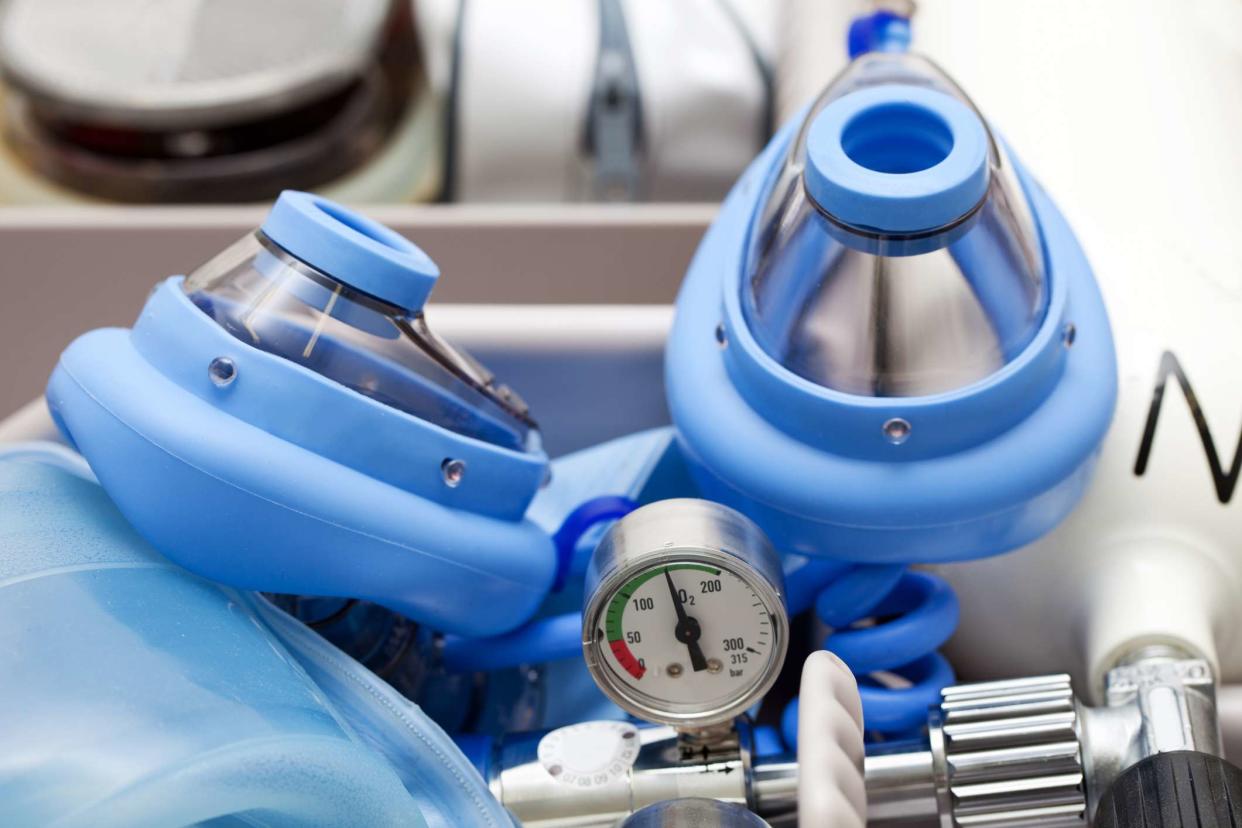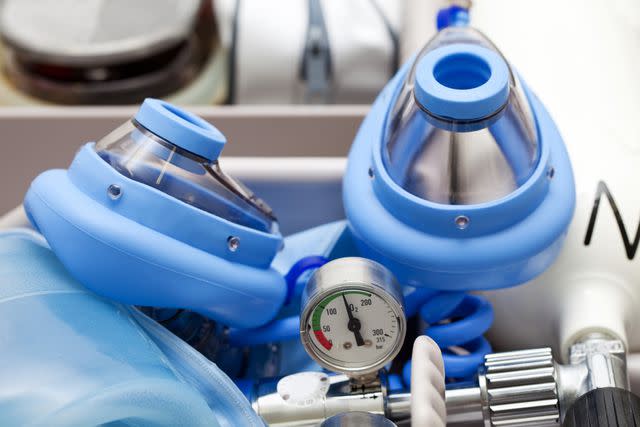Brain Injury From Anoxia

choja / Getty Images
Medically reviewed by Smita Patel, MD
Anoxia is a condition in which the body or parts of the body do not receive oxygen to function correctly. This can occur due to a lack of oxygen to the entire body (typically in newborns during a difficult delivery), respiratory failure, or other medical conditions.
Anoxia is different from hypoxia, as anoxia is a complete lack of oxygen, whereas hypoxia is some lack of oxygen. Anoxia can cause serious health complications, including brain damage and organ failure, and can even be fatal if left untreated.
In this article, learn more about anoxia symptoms, how to diagnose anoxic injury, the treatment (short-term and long-term), and the complications.

choja / Getty Images
Definition of Anoxia
Anoxia is an emergency since the body and its organs need oxygen. It is defined as a complete lack of oxygen. You might think about anoxia in levels of oxygen deprivation like the following:
Lack of oxygen to a specific organ (such as the brain in a stroke)
Lack of oxygen because the body cannot distribute the oxygen appropriately (cardiac failure or carbon monoxide poisoning)
Lack of oxygen to the body because a person cannot take in oxygen (respiratory failure, strangulation)
Lack of oxygen in the surrounding environment (e.g., drowning, lack of oxygen to a newborn during a difficult delivery)
The difference between anoxia and hypoxia is that anoxia refers to a complete lack of oxygen, while hypoxia refers to a partial lack of oxygen. In hypoxia, the body still receives some oxygen, but not enough to function properly.
In stroke, anoxia occurs when blood flow to the brain is blocked, depriving the brain of oxygen. This can cause brain damage if not treated promptly.
In cardiac failure, like a heart attack, anoxia occurs when the heart cannot pump enough blood to the rest of the body, depriving the body and the organs of oxygen. This can cause organ failure and other serious health complications.
Carbon monoxide poisoning occurs when the colorless, odorless gas is inhaled (e.g., from the buildup from gas stoves, grills, or indoor heaters). Carbon monoxide binds to hemoglobin in the blood, preventing oxygen from being transported to the body's tissues.
Learn More:How Long Does Brain Activity Last After Cardiac Arrest?
Respiratory failure is another condition that can cause anoxia and, in isolation (without cardiac failure), more often occurs in children. It happens when the lungs cannot take in oxygen to oxygenate the blood. Essentially, anoxia from respiratory failure occurs when a person stops breathing.
Finally, anoxia can occur when the environment does not have oxygen. This happens during drowning, for example, but more often occurs in newborns during a difficult delivery or when a neophyte (newborn) is born prematurely. Newborns are at risk for anoxic brain injury since the lungs are the last organ to mature before birth.
When babies are born prematurely and the lungs are not fully developed, they can suffer anoxic brain injury. Another cause of anoxic brain injury in this group includes birthing problems, such as when the umbilical cord is wrapped around the neonate's neck. Anoxia during delivery can lead to cerebral palsy, a disorder that affects brain function.
Approximately 1 million people have cerebral palsy in the United States, and about 18 million people of all ages have cerebral palsy worldwide. It is the most common lifelong physical disability in the world.
Is Anoxia an Emergency?
Anoxia is a medical emergency that requires immediate attention. When the body does not have enough oxygen, the brain and other vital organs can be damaged within minutes. Therefore, it is important to call for emergency medical services as soon as possible if you suspect anoxia.
Early intervention can greatly improve the outcome for someone experiencing anoxia, so it is essential to act quickly.
Symptoms of Anoxia
The symptoms of hypoxia and anoxia are similar at the onset since both problems are associated with less oxygen than what the body needs. Symptoms of hypoxia can include:
Shortness of breath and difficulty breathing
Headache
Confusion
Restlessness
Palpitations and a rapid heartbeat
Symptoms of anoxia can include:
The severity of symptoms can depend on the duration and degree of oxygen deprivation. It's important to seek medical attention immediately if either of these conditions is suspected, as they can lead to serious complications.
Long-Term Symptoms and Complications
Symptoms of anoxic brain injury after recovery from a lack of oxygen are variable and depend on how long a person was without oxygen. Long-term complications include the following:
Organ dysfunction and failure (e.g., kidney failure, heart failure)
Lack of consciousness
Seizure-like activity or jerking movements
Motor problems
Speech impairments
Memory difficulties
Irritability
Spasticity (increased muscle tone and stiffness)
Hearing problems
Behavioral problems
Symptoms of cerebral palsy vary based on the severity of anoxia, but half of people with cerebral palsy have intellectual problems, and many cannot walk, talk, or feed themselves.
Related:Cerebral Palsy: Facts and Statistics: What You Need to Know
While infants can have cerebral palsy or hypoxic-ischemic encephalopathy after an anoxic event, adults can also suffer from long-term complications, including:
Difficulties with coordination
Muscle weakness
Mobility issues
Memory loss
Attention deficits
Difficulty with problem-solving and decision-making
Depression
Anxiety
Personality changes
Chronic heart and lung problems
Testing to Diagnose Anoxia
Healthcare providers diagnose anoxia itself clinically at the time of the event. The diagnosis is based on oxygen levels in the blood (tested through pulse oximetry or blood tests) and skin color.
Diagnosing complications from anoxia or conditions related to anoxia, like cerebral palsy, may require various tests depending on the severity and underlying cause of anoxia and the disease. These tests may include the following:
Blood tests
Imaging tests like magnetic resonance imaging (MRI)
Electroencephalogram (EEG)
Developmental testing
Related:How Cerebral Palsy Is Diagnosed
There are four types of cerebral palsy: spastic, dyskinetic, ataxic, and mixed types of cerebral palsy. Each is diagnosed through developmental and neurological testing (testing of disorders of the nervous system).
Immediate Anoxia Treatment
Treatment for anoxia depends on the underlying cause of the condition. In cases of respiratory failure or a lack of oxygen in the environment, healthcare providers will administer oxygen to a person. If the heart stops, they try to restart the heart. In short, the treatment for anoxia is giving the person oxygen and treating the problem that led to anoxia.
Long-Term Anoxia Treatment
Long-term anoxia treatment typically involves addressing the underlying cause and managing the complications. Depending on the severity of the anoxia, treatment may include supportive care such as oxygen therapy, chronic mechanical ventilation, and medications to control symptoms such as seizures, pain, and behavioral problems.
Each individual's recovery pathway is different and depends on the duration of anoxia. Some individuals recover quickly while others may experience ongoing difficulties with everyday tasks and activities.
Rehabilitation and supportive care are critical components of managing the long-term effects of anoxia, and ongoing medical and therapeutic interventions may be necessary to address any new or worsening symptoms.
Rehabilitation and physical therapy may be necessary to help the person regain strength and function. Specific surgical procedures can help with spasticity often associated with neurological problems like cerebral palsy.
Assistive devices (braces and splints, wheelchairs, hearing aids, glasses) can help overcome the challenges of daily living. Long-term management of anoxia and its associated complications can be challenging and requires a multidisciplinary approach involving a team of healthcare professionals.
Early intervention and school-aged services are available through the U.S. special education law known as the Individuals with Disabilities Education Act (IDEA). IDEA provides early intervention services to help children learn new skills and offers help with developmental disabilities through the public school system.
Summary
Anoxia is a severe medical condition that can cause brain damage, organ failure, and even death if left untreated. Various factors, including stroke, heart attack, respiratory failure, carbon monoxide poisoning, and a lack of oxygen in the environment, can cause it.
One of the most common complications of anoxia is neurologic dysfunction, such as cerebral palsy. Diagnosis is based on a variety of tests, including developmental testing.
Treatment for anoxia depends on the underlying cause, and a multidisciplinary approach involving a team of healthcare professionals is often required to manage the long-term symptoms of anoxia. If you suspect that you or someone you know may be experiencing anoxia, it is crucial to seek prompt medical attention to prevent serious health complications.

